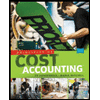
Managerial Accounting
15th Edition
ISBN: 9781337912020
Author: Carl Warren, Ph.d. Cma William B. Tayler
Publisher: South-Western College Pub
expand_more
expand_more
format_list_bulleted
Question
Chapter 4, Problem 6DQ
To determine
Discuss the allocation of selling and administrative expenses to product cost as per GAAP.
Expert Solution & Answer
Want to see the full answer?
Check out a sample textbook solution
Students have asked these similar questions
Get correct answer with accounting
Please provide the solution to this financial accounting question with accurate financial calculations.
Yamamoto Corporation began the accounting period with $92,000 of merchandise, and the net cost of purchases was $318,000. A physical inventory showed $104,000 of merchandise unsold at the end of the period. The cost of goods sold by Yamamoto Corporation for the period is __.
Chapter 4 Solutions
Managerial Accounting
Ch. 4 - Why would management be concerned about the...Ch. 4 - Why would a manufacturing company with multiple...Ch. 4 - Prob. 3DQCh. 4 - Prob. 4DQCh. 4 - How does activity-based costing differ from the...Ch. 4 - Prob. 6DQCh. 4 - Prob. 7DQCh. 4 - Under what circumstances might the activity-based...Ch. 4 - Prob. 9DQCh. 4 - Prob. 10DQ
Ch. 4 - Single plantwide factory overhead rate The total...Ch. 4 - Multiple production department factory overhead...Ch. 4 - Activity-based costing: factory overhead costs The...Ch. 4 - Activity-based costing: selling and administrative...Ch. 4 - Activity-based costing for a service business...Ch. 4 - Kennedy Appliance Inc.s Machining Department...Ch. 4 - Bach Instruments Inc. makes three musical...Ch. 4 - Scrumptious Snacks Inc. manufactures three types...Ch. 4 - Isaac Engines Inc. produces three productspistons,...Ch. 4 - Handy Leather, Inc., produces three sizes of...Ch. 4 - Eclipse Motor Company manufactures two types of...Ch. 4 - The management of Nova Industries Inc....Ch. 4 - Comfort Foods Inc. uses activity-based costing to...Ch. 4 - Nozama.com Inc. sells consumer electronics over...Ch. 4 - Hercules Inc. manufactures elliptical exercise...Ch. 4 - Lonsdale Inc. manufactures entry and dining room...Ch. 4 - Activity cost pools, activity rates, and product...Ch. 4 - Handbrain Inc. is considering a change to...Ch. 4 - Prob. 14ECh. 4 - Activity-based costing and product cost distortion...Ch. 4 - Prob. 16ECh. 4 - Evaluating selling and administrative cost...Ch. 4 - Prob. 18ECh. 4 - Prob. 19ECh. 4 - Activity-based costing for a service company...Ch. 4 - Bounce Back Insurance Company carries three major...Ch. 4 - Gwinnett County Chrome Company manufactures three...Ch. 4 - The management of Gwinnett County Chrome Company,...Ch. 4 - Activity-based and department rate product costing...Ch. 4 - Activity-based product costing Mello Manufacturing...Ch. 4 - Allocating selling and administrative expenses...Ch. 4 - Product costing and decision analysis for a...Ch. 4 - Single plantwide factory overhead rate Spotted Cow...Ch. 4 - Multiple production department factory overhead...Ch. 4 - Activity-based department rate product costing and...Ch. 4 - Activity-based product costing Sweet Sugar Company...Ch. 4 - Allocating selling and administrative expenses...Ch. 4 - Product costing and decision analysis for a...Ch. 4 - Life Force Fitness, Inc., assembles and sells...Ch. 4 - Prob. 2MADCh. 4 - Prob. 3MADCh. 4 - Production run size and activity improvement...Ch. 4 - Prob. 5MADCh. 4 - Ethics in Action The controller of Tri Con Global...Ch. 4 - Communication The controller of New Wave Sounds...Ch. 4 - Pelder Products Company manufactures two types of...Ch. 4 - The Chocolate Baker specializes in chocolate baked...Ch. 4 - Young Company is beginning operations and is...Ch. 4 - Cynthia Rogers, the cost accountant for Sanford...
Knowledge Booster
Similar questions
- Please provide the correct answer to this general accounting problem using accurate calculations.arrow_forwardCan you help me solve this financial accounting question using the correct financial procedures?arrow_forwardPlease explain the solution to this financial accounting problem with accurate explanations.arrow_forward
- Please explain this financial accounting problem with accurate financial standards.arrow_forwardCan you demonstrate the accurate method for solving this financial accounting question?arrow_forwardIn the first month of operations, the total of the debit entries to the cash account for Pulp Company amounted to $7,800, and the total of the credit entries to the cash account amounted to $5,250.What is the balance in the cash account at the end of the month?arrow_forward
arrow_back_ios
SEE MORE QUESTIONS
arrow_forward_ios
Recommended textbooks for you
 Managerial AccountingAccountingISBN:9781337912020Author:Carl Warren, Ph.d. Cma William B. TaylerPublisher:South-Western College Pub
Managerial AccountingAccountingISBN:9781337912020Author:Carl Warren, Ph.d. Cma William B. TaylerPublisher:South-Western College Pub Managerial Accounting: The Cornerstone of Busines...AccountingISBN:9781337115773Author:Maryanne M. Mowen, Don R. Hansen, Dan L. HeitgerPublisher:Cengage Learning
Managerial Accounting: The Cornerstone of Busines...AccountingISBN:9781337115773Author:Maryanne M. Mowen, Don R. Hansen, Dan L. HeitgerPublisher:Cengage Learning Cornerstones of Cost Management (Cornerstones Ser...AccountingISBN:9781305970663Author:Don R. Hansen, Maryanne M. MowenPublisher:Cengage Learning
Cornerstones of Cost Management (Cornerstones Ser...AccountingISBN:9781305970663Author:Don R. Hansen, Maryanne M. MowenPublisher:Cengage Learning Financial And Managerial AccountingAccountingISBN:9781337902663Author:WARREN, Carl S.Publisher:Cengage Learning,Principles of Accounting Volume 2AccountingISBN:9781947172609Author:OpenStaxPublisher:OpenStax College
Financial And Managerial AccountingAccountingISBN:9781337902663Author:WARREN, Carl S.Publisher:Cengage Learning,Principles of Accounting Volume 2AccountingISBN:9781947172609Author:OpenStaxPublisher:OpenStax College Principles of Cost AccountingAccountingISBN:9781305087408Author:Edward J. Vanderbeck, Maria R. MitchellPublisher:Cengage Learning
Principles of Cost AccountingAccountingISBN:9781305087408Author:Edward J. Vanderbeck, Maria R. MitchellPublisher:Cengage Learning

Managerial Accounting
Accounting
ISBN:9781337912020
Author:Carl Warren, Ph.d. Cma William B. Tayler
Publisher:South-Western College Pub

Managerial Accounting: The Cornerstone of Busines...
Accounting
ISBN:9781337115773
Author:Maryanne M. Mowen, Don R. Hansen, Dan L. Heitger
Publisher:Cengage Learning

Cornerstones of Cost Management (Cornerstones Ser...
Accounting
ISBN:9781305970663
Author:Don R. Hansen, Maryanne M. Mowen
Publisher:Cengage Learning

Financial And Managerial Accounting
Accounting
ISBN:9781337902663
Author:WARREN, Carl S.
Publisher:Cengage Learning,

Principles of Accounting Volume 2
Accounting
ISBN:9781947172609
Author:OpenStax
Publisher:OpenStax College

Principles of Cost Accounting
Accounting
ISBN:9781305087408
Author:Edward J. Vanderbeck, Maria R. Mitchell
Publisher:Cengage Learning